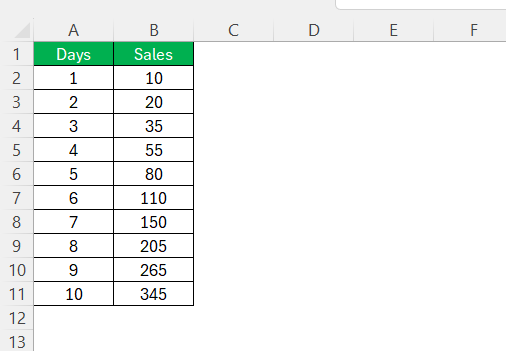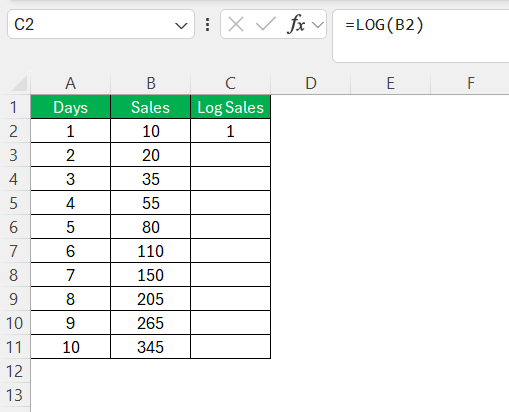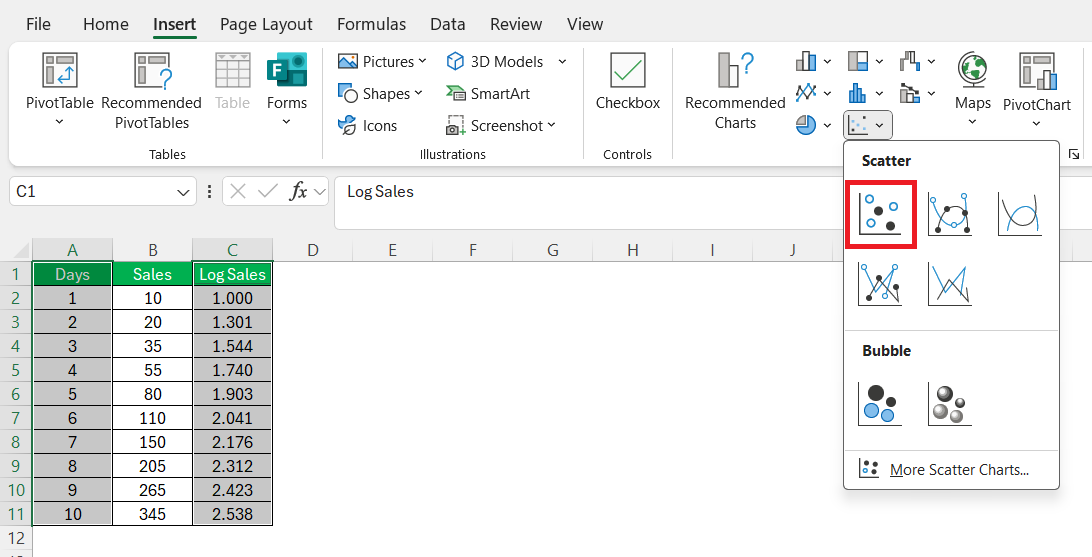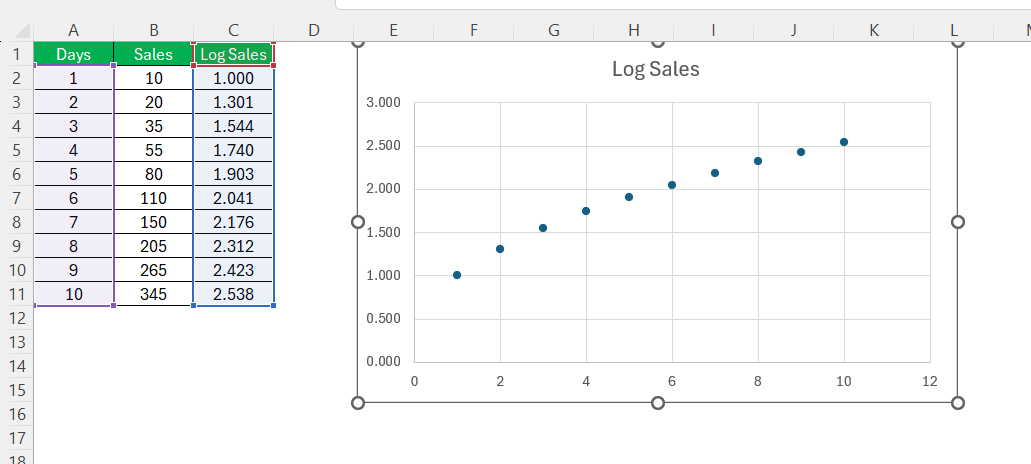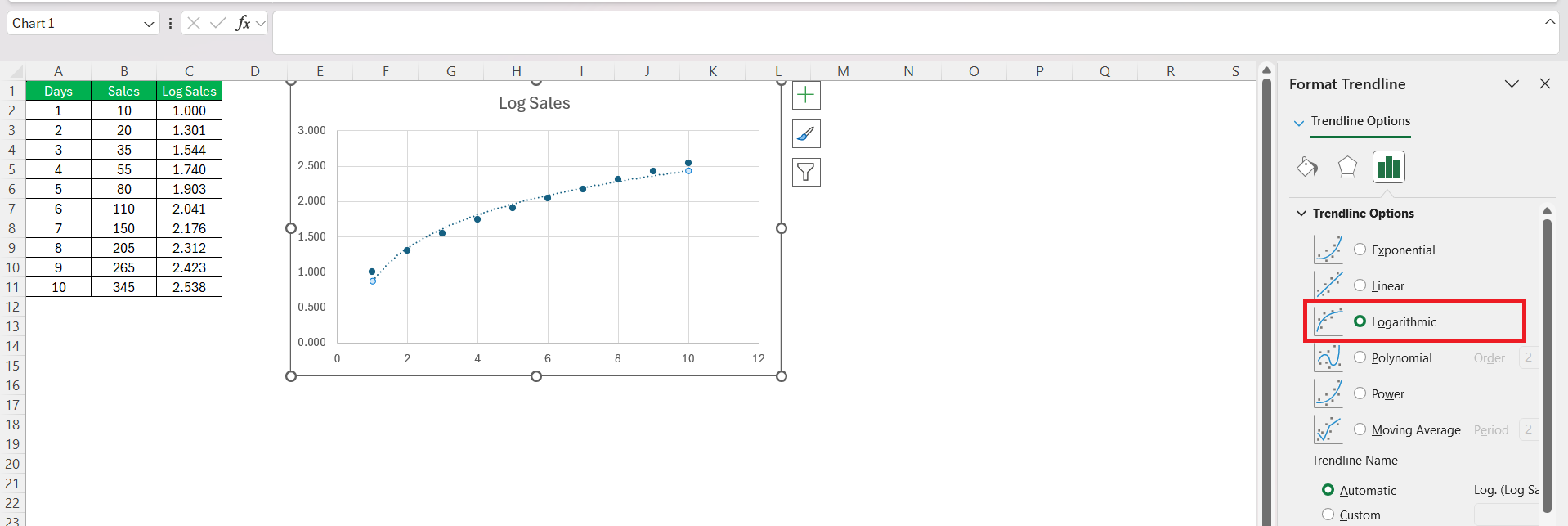When working with data in Excel, I’ve often encountered situations where the growth rate isn’t constant. Traditional linear growth assumes a steady rate of increase, but in the real world, many growth patterns, like population growth, cell division, and even some economic metrics, follow a logarithmic trend.
Today, I’ll walk you through how I handle logarithmic growth in Excel, from understanding the basics to visualizing it and applying functions that simplify my work.
Key Takeaways:
- Logarithmic Growth Basics: Logarithmic growth starts fast but slows down over time, making it ideal for analyzing trends that level off, like population growth.
- Using Excel’s LOG Function: The LOG function transforms exponential growth into a linear form, making complex trends easier to analyze.
- Step-by-Step Calculation: In Excel, create a column with logarithmic values and visualize growth by adding a logarithmic trendline to a scatter plot.
- Handling Data Correctly: Always use positive values for logarithmic calculations and adjust constants for accurate trend alignment.
- Practical Applications: Logarithmic scales in charts can highlight trends clearly, especially in datasets with wide-ranging values.
Table of Contents
Unlocking the Mystery of Logarithmic Growth in Excel
What is Logarithmic Growth?
Before diving into Excel, I would like to clarify what logarithmic growth actually means. Unlike linear growth, where we see consistent increases over time, logarithmic growth starts off fast and slows down over time. The rate of growth decreases as the x-values increase, following a curve that resembles a rapid rise followed by a tapering off. A real-world example could be the spread of information or population growth in an environment with limited resources. The underlying formula is usually something like this:
y=a log(x)+b
Here, a and b are constants that define the steepness and vertical shift of the curve. The logarithmic function is useful for plotting data that spikes and then levels out.
Understanding Logarithmic Functions
In Excel, logarithmic functions are akin to deciphering a secret code that sheds light on data complexity. When we talk about growth, especially the kind that doesn’t increase at a constant rate but, rather, accelerates over time, we’re often talking about exponential growth. And that’s where logarithmic functions shine brightly.
Understanding logarithmic functions means that we perceive how to transform multiplicative processes into additive ones. Within Excel, the LOG function refers to this transformation, allowing us to dissect exponential growth trends with ease. By converting data to a logarithmic scale, what once appeared as a daunting, steep curve can become a manageable straight line, providing clarity and focus on growth patterns.
Harnessing the Power of Excel’s LOG Function
Exploring the Syntax and Usage
The LOG function in Excel is straightforward to use once you get the hang of it. The syntax for the LOG function is
=LOG(number, [base])
numberrefers to the positive real number for which you want to find the logarithm[base]is the base of the logarithm, which is optional and defaults to 10 if not provided.
If you want to find the natural logarithm, use the base e by employing the function LN instead or setting the base as EXP(1).
Excel will return the logarithm of the number to the base you have chosen. It’s a tool that can transform exponential growth figures into a format that’s much easier to analyze, compare, and understand.
Step-by-Step Guide to Calculate Logarithm Growth in Excel
Let’s calculate logarithmic values in Excel using a simple example. I’ll use a small dataset of daily sales to analyze growth over time.
STEP 1: Set Up Data
I start by creating a table. In column A, I label it “Days” and enter numbers 1 through 10. These represent each day. In column B, I label it “Sales” and enter values like 10, 20, 35, 55, and 80. The numbers should increase to show growth over time.
STEP 2: Select Logarithmic Base
For this example, I’ll use base 10, which is the default in Excel’s LOG function. This base works well for general purposes.
STEP 3: Use the LOG Function
I click on cell C2 under a new column titled “Log Sales.” In C2, I enter:
=LOG(B2)
This calculates the base-10 logarithm of the value in cell B2. After pressing Enter, Excel shows the result in C2.
STEP 4: Copy the Formula Down
To calculate for all days, I copied this formula down to the “Log Sales” column. I click on cell C2, drag the fill handle down, and Excel fills in the rest.
The “Log Sales” values show the rate of growth slowing down. This pattern, where the growth rate decreases over time, is the essence of logarithmic growth.
STEP 5: Create a Scatter Plot
To visualize the data, I highlight columns A and C. Then, I go to Insert > Scatter Plot and select Scatter with Straight Lines.
Excel displays the sales growth trend over time.
STEP 6: Add a Logarithmic Trendline
I click on any data point to emphasize the trend, choose Add Trendline, and select Logarithmic.
The trendline now clearly shows the rapid initial growth that gradually slows down. This method lets me easily analyze and visualize logarithmic growth in Excel.
Practical Tips for Working with Logarithmic Data in Excel
- Choose Constants Wisely: Adjusting the constants aaa and bbb will help fit the logarithmic model to real data. I play around with these until the curve aligns closely with the observed data.
- Double-Check for Zero Values: The logarithm of zero is undefined, so I always ensure my x-values start from positive numbers and never contain zero.
- Use Logarithmic Scale for Clearer Visuals: When data spans several orders of magnitude, a log scale on the chart’s y-axis can make trends more visible. I do this, especially for financial data or web metrics.
FAQs on Mastering Logarithmic Growth in Excel
What is the log function in Excel?
The LOG function in Excel calculates the logarithm of a number to a specified base, which is essential when analyzing data that grows exponentially. It transforms complex growth rates into a linear form, making them easier to interpret and compare across different data sets.
How Do I Apply the LOG Function to a Dataset in Excel?
To apply the LOG function to a dataset in Excel, first ensure your data is positive. Select a cell where you want the result, enter =LOG(, click on the cell with the number, add a comma if you want to specify a base other than 10, then close the parenthesis and press Enter. Repeat for each data point or use autofill.
How do you calculate logarithmic growth in Excel?
To calculate logarithmic growth in Excel, use the GROWTH function to predict y-values based on new x-values and fit a logarithmic curve to your data. Alternatively, use LOG to determine growth rates across time periods and compare proportional changes over time.
What Are Some Common Issues Faced While Using the GROWTH Function?
Common issues when using the GROWTH function include the #REF! error if known_x's and known_y's arrays have different lengths, the #NUM! error if the known_y's values are less than or equal to zero, and the #VALUE! error for non-numeric entries.
How to use the log function in Excel effectively?
To use the LOG function effectively in Excel, ensure your numbers are positive as it only applies to positive values. Select the appropriate base for your analysis, with e for natural logarithms and 10 for common logarithms. Break down complex calculations into simpler steps and use the function alongside other Excel tools like charts for visual aids.
John Michaloudis is a former accountant and finance analyst at General Electric, a Microsoft MVP since 2020, an Amazon #1 bestselling author of 4 Microsoft Excel books and teacher of Microsoft Excel & Office over at his flagship MyExcelOnline Academy Online Course.

